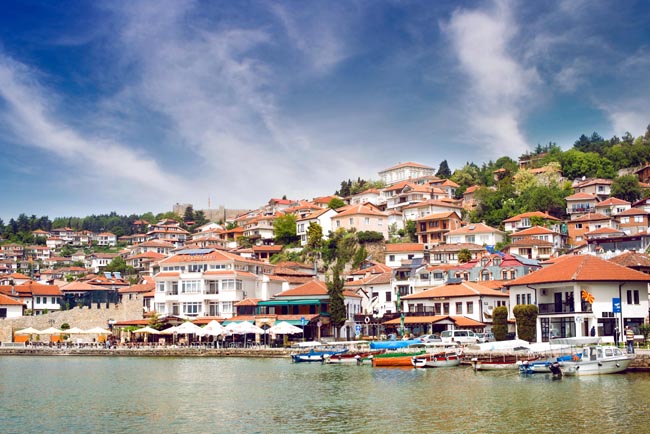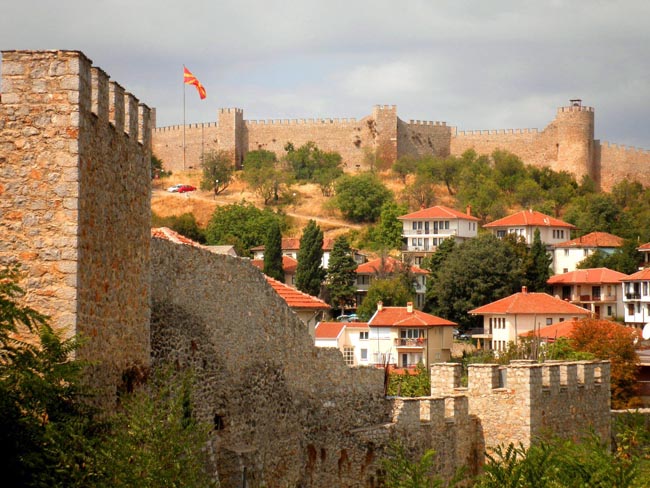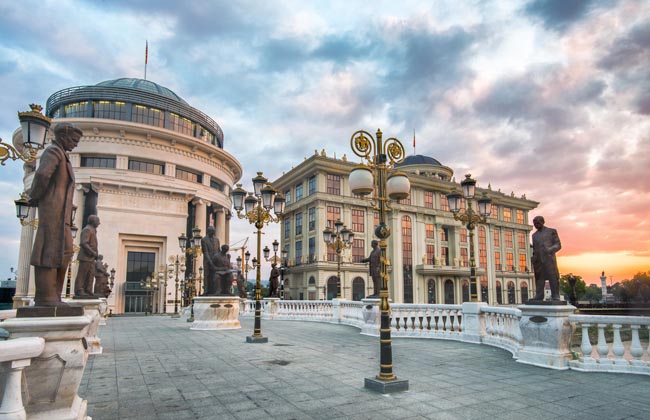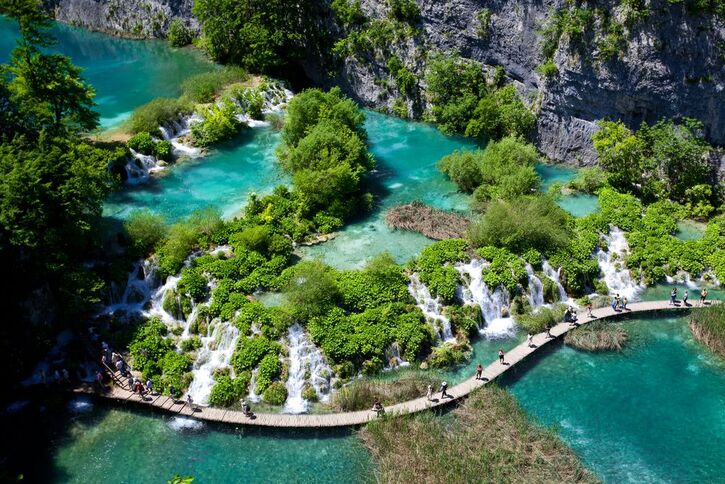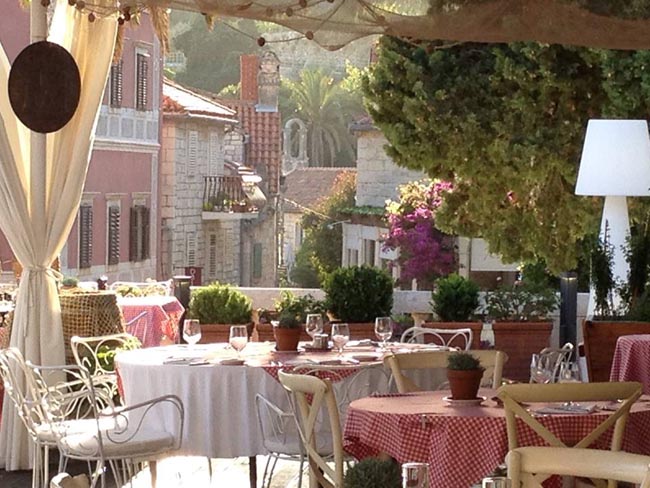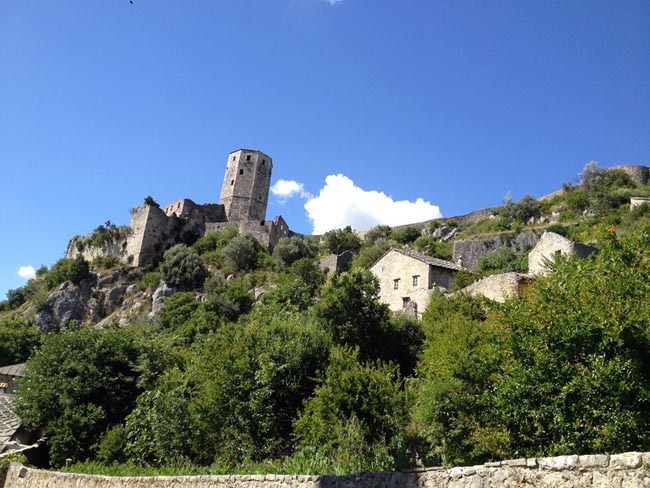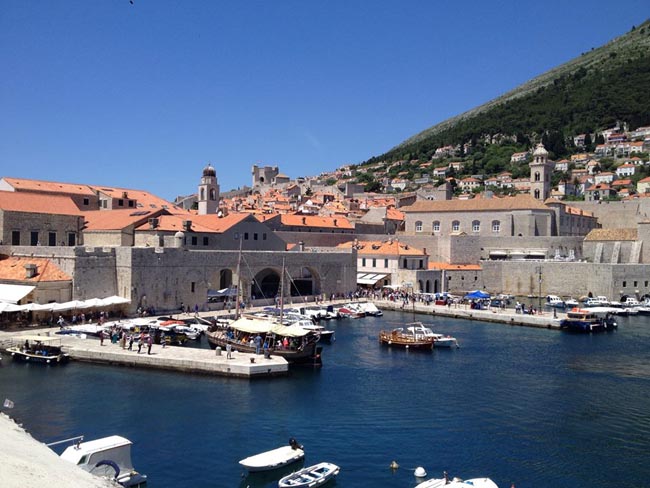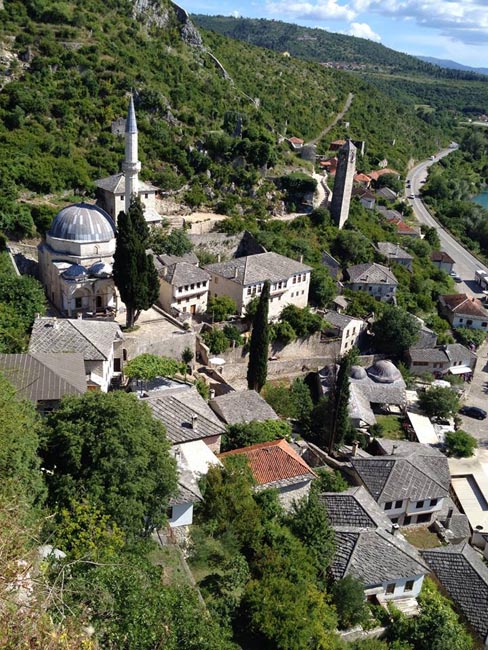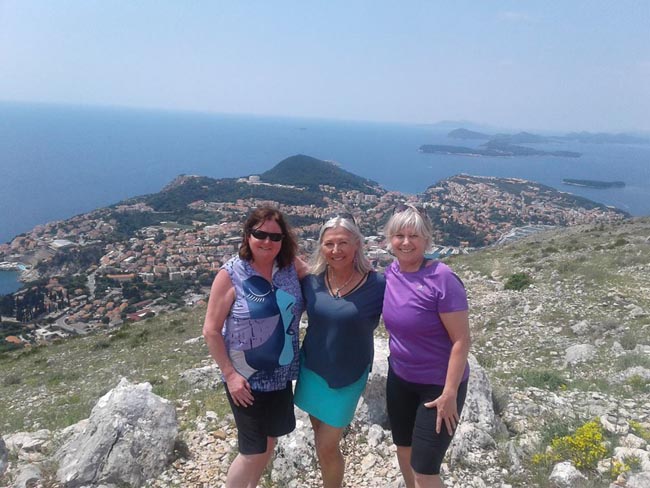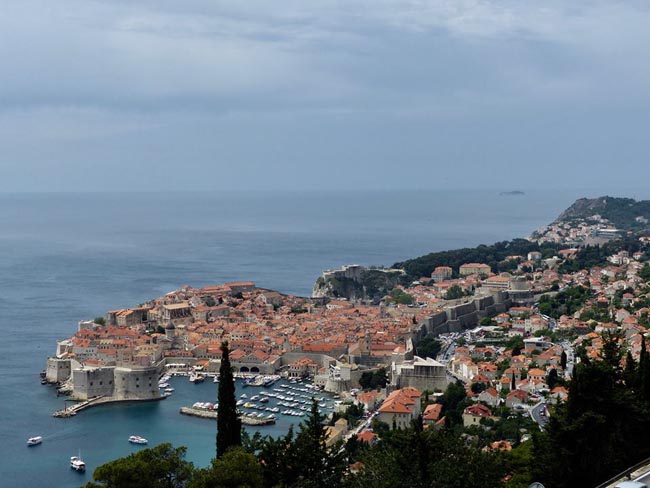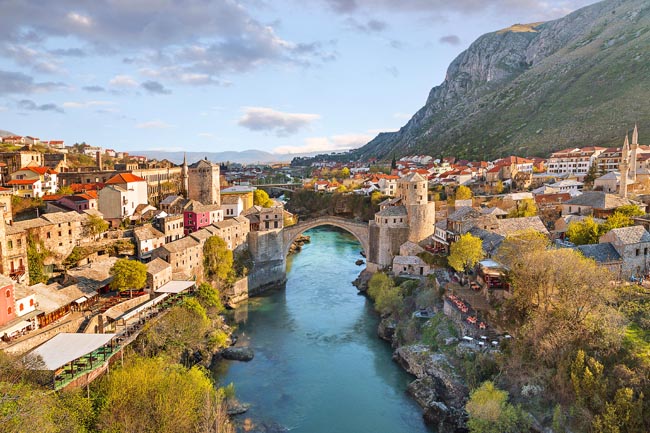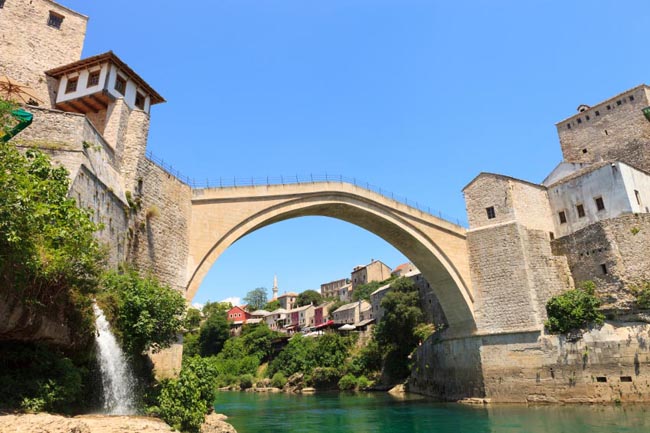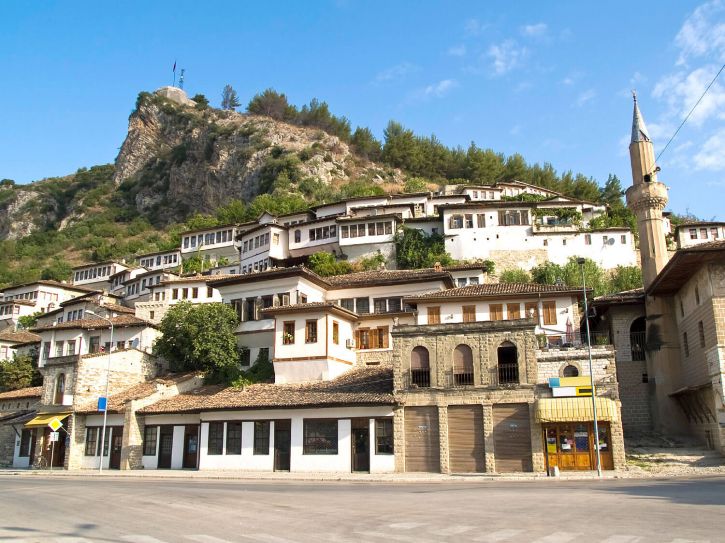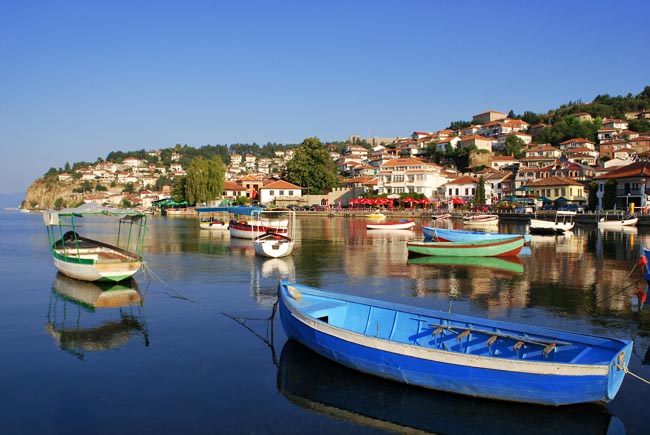Our Adriatic, Albania & Macedonia Tour begins in Slovenia, past glacial lakes, lush green valleys and majestic mountain ranges, and venture through culturally fascinating small towns bustling cities and quaint hamlets brimming with historic sites of interest.
We enjoy a easy-paced walking tour of the capital, Ljubljana, a city that reminds one of Vienna and Prague, before heading into Croatia and exploring the Istrian Peninsula, a region rife with ancient Roman and Illyrian relics and monuments.
With the convergence of 16 lakes in a series of cascading waterfalls, the Plitvice Lakes is a destination of unique natural beauty and one that has been designated a UNESCO World Heritage Site and from here, we travel along the Dalmatian coast, taking in the centuries-old cathedrals, monasteries and fortresses that dot the Croatian countryside.
We venture into Bosnia and Herzegovina, where we bear witness to a blend of Mediterranean and Oriental architecturE.
After a memorable drive along the breathtaking Adriatic coast, we make for Tirana, Albania, and expose ourselves to the intriguing contemporary culture of this destination that lays claim to a fabulous collection of wondrous mosques as well as innumerable archaeological artifacts that detail almost 3,000 years of history.
We travel farther afield from the capital, stopping in at various towns and cities along the Albanian Riviera and beyond to appreciate Roman amphitheatres, ancient bridges, Franciscan churches and glorious panoramas.
Prices below are per person, twin-sharing costs in US Dollars (USD). Pricing does not include airfare to/from the tour and any applicable taxes. For single supplement rates and taxes (if any), please refer to below Prices & Dates table. For general information on flights to/from the tour, click here.
Your Travel and Accomodations Arranged For You
(With English Speaking Guides and Staff.)
Driver, Dinner, and Local Guide Tips Included.
Authentic Local Experiences With Lots Of Inclusions.
Select a date below to reserve your spot:
Optional Single Supplement: $1620 USD (number of singles limited).
Download Itinerary
Day 1 Arrive in Ljubljana, Slovenia
Arrive in Ljubljana, the capital of Slovenia.
Overnight Ljubljana.
Included Meal(s): Dinner
Day 2 Ljubljana: City Tour
Today we enjoy a walking tour of "Bela Ljubljana". This was the nickname given to this delightful city after it was entirely rebuilt following a major earthquake in 1511. A walk through the streets of this charming city reminds one of Vienna and Prague. However, Ljubljana is tiny in comparison, and easily visited on foot. We go up to the highest point of the city to visit the 16th century castle; the castle today houses a Virtual Museum, which gives a superb overview of the city's history, and a climb up the main tower affords a wonderful panorama of the town and surrounding mountains.
We then visit the old town by foot, stopping along the way to see the Parliament building, university, beautiful squares, and unique bridges. We also see the city's Cathedral, with its modern bronze doors commemorating the history of Slovenia and its struggle towards independence. A tour of Ljubljana would not be complete without a stroll through the great outdoor markets, where locals come to buy fresh mountain herbs and flowers, wild mushrooms, and fresh fruit and vegetables from nearby farms.
Overnight Ljubljana.
Included Meal(s): Breakfast and Dinner
Not finding what you're looking for?
Our specialists can take away the stress and create a private custom tour tailored to your exact interests and budget.
Day 3 Ljubljana - Skofja Loka - Kropa - Bled
Today we drive through the countryside, with small hamlets and farms scattered across the green rolling hills. This area has some of this new nation's oldest inhabited settlements, three of which we will visit today. Our first stop today is Skofja Loka, or "Bishop's Meadow," one of the most charming towns in Slovenia with its historic streets, houses and its castle perched high above. We will wander the Mestni Trg, the main street of the town, see the Granary, St. James' Church, Homan house, and visit the 13th century castle, which today houses the finest ethnographic museum in the country.
Our drive continues through small hamlets, with traditional farmhouses and steepled churches, where crops of potatoes, corn, turnips and hay are grown. Our next stop is Kropa, a tiny town on the Kroparica River which was historically famous for its iron forging industry. The forges here produced iron objects of all kinds were traded throughout Europe. From the huge spikes which were used in the construction Venice, to the tiny tacks used in Austrian mountaineering boots, Kropa produced over 130 varieties of nails.
We drive through spectacular scenery to Bled, where we will spend two nights. Bled is located on the edge of an emerald green glacial lake. The views upon approach are stupendous, with the town's castle perched above, Bled Otok, the small island with a church in the center of the lake, all set against the spectacular backdrop of the Karavanke Mountains and Julian Alps.
Overnight in Bled.
Included Meal(s): Breakfast and Dinner
Day 4 Bled & Lake Bohinj
Reflecting the high mountain peaks, Lake Bled has always been considered sacred by the locals. Our first visit is to the 11th century castle which houses a small museum and provides magnificent views of town, lake and mountains. After our visit we will catch a small traditional boat, or pletna, to visit the country's only island, Bled Otok. On the island we will visit the Church of St. Mary of the Assumption, also known as "Our Lady of the Lake". Legend has it that if you make a wish while ringing the bell your wish will come true.
This afternoon we drive through lush green valleys to Bohinj, one of the gateways to the Julian Alps. The name Bohinj refers to the entire valley and its numerous small settlements. Lake Bohinj is the largest permanent lake in Slovenia, and protected from development. It is fed by the Savica waterfall, which Slovenia's greatest poet, Francis Preseren celebrated in his poem "Baptism at the Savica Waterfall". We will visit the Church of St. John the Baptist, famous for its beautiful frescoes, located on the lake's edge in the charming town of Bohinjska Bistrica.
Further along the lake's shores we will take a cable car which climbs 1537m / 5,072 ft up to Mt Vogel, the only mountain ski resort within Triglav National Park. On a clear day we can view the peaks of the Julian Alps, some of the highest in the country, and see Mt. Triglav, a holy mountain and national symbol of Slovenia. There is also a spectacular panorama of Lake Bohinj and basin.
Upon our return to Bled, you may choose to walk around the shores of Bled, or even swim (!); an excellent path takes you on a 6km (3.75 mi) walk around the lake.
Overnight in Bled.
Included Meal(s): Breakfast and Dinner
Day 5 Bled - Kranjska Gora - Kobarid
This morning travel to Triglcav National Park. Our First stop will be at Kranjska Gora, popular winter and summer tourist resort for a short walk. Then continue via the mountain pass of Predil into the Log pod Mangrtom town -- a small town that was devastated by an avalanche in 2000.
We drive to the pretty town of Bovec nestled in the Soca Valley and near the Kanin ridge, the highest ski resort in the country. We finish our day just down the road at Kobarid, known for the Battle of Caporetto where the Italian retreat was documented by Ernest Hemingway in his novel 'A Farewell to Arms.'
We will go up to the Italian Charnel house and Church of St. Antony, located on a hill above Kobarid town. It houses the bones of over 7,000 Italian soldiers killed here during World War I. The church was redesigned in the 20th century by an Italian architect, when the bones were gathered from the surrounding valleys and placed here; Mussolini himself dedicated the church and Charnel house in 1938.
Overnight in Kobarid.
Included Meal(s): Breakfast and Dinner
Day 6 Kobarid - Predjama - Postojna Caves - Piran
Driving the along the banks of the Soca River, we make our way out of Alpine territory to the region and plateau of Primorska. The Soca is a valley of wonderful colours, full of waterfalls, pools, ravines and canyons, with its own distinct flora and fauna. The impossibly blue-green Soca River flows over white gravel and through a fairy-tale landscape with a stunning vista at every turn.
Our next stop is Predjama Castle, located in the middle of a 123m (403 ft) high, overhanging, limestone cliff, in the entrance of a cave. The cave was utlitised by a robber baron from centuries ago to become his stronghold. It's been described as a "masterpiece of medieval ingenuity, courage, cunning and defiance". Its white walls, roofs, turrets and chimneys jutting from the mountainside, built onto solid rock, make it the most unique and picturesque fortress you will ever come across in Europe.
We continue through the limestone plateau, or "karst" region en route to the Postojna Caves where we have a guided visit. This region was once submerged by a deep sea; today the landscape is characterized by subterranean rivers which have carved out magnificent caves, and by the rich red soil deposits in poljes, the depressions left when caverns collapse. The cave is 27 km (17 miles) long and over 2 million years old, and consists of a series of caverns, halls and passages with enormous stalactites and stalagmites. The caves also have their own unique ecosystem, flora and fauna; the most famous creature endemic to the caves is the so called Proteus Anguinus, or "human fish", a small pink, blind type of salamander equipped with both gills and rudimentary lungs.
We continue to Piran, Istria, beautifully located on the Adriatic. The town resembles a large open-air museum, with medieval architecture and a rich cultural heritage. Narrow streets and compact houses give the town its special charm.
Overnight in Piran.
Included Meal(s): Breakfast and Dinner
Day 7 Piran, Slovenia - Porec, Croatia - Pula - Opatija
We depart Piran and continue by road across the border into Croatia where our first stop is Porec, a pretty seaside town dating back to the Roman period. We will walk through the ancient narrow lanes, see the ruins of the Roman Temple of Augustus, and visit the Euphrasian Basilica. This church houses some of the finest Byzantine mosaics in the world, comparable to those in Ravenna. The Basilica is listed among many other Croatian masterpieces of art and architecture, as a protected UNESCO World Heritage site.
We also stop in Pula, called Pola by the first Illyrian settlers and Polensium by the Romans. We visit one of the most impressive sites in town, the amphitheater, located near the harbour. Built entirely of local limestone, the amphitheater was designed to host gladiatorial contests and could accommodate up to 22,000 spectators.
We finish our day in Opatija, the oldest established and still one of the most popular Croatian resorts. A Rijeka businessman built the first villa here in 1844, and after a visit by the trend-setting wife of the Austrian Emperor, the town was promoted as a handy health resort for aristocratic Austrians.
(Depending on hotel availability, we may overnight in Opatija or continue the short distance to Rijeka.)
Overnight in Opatija or Rijecka.
Included Meal(s): Breakfast and Dinner
Day 8 Opatija - Zagreb
Today we travel inland to the capital, Zagreb.
From its intriguing architecture to nearby natural havens, this underrated European capital has something for everyone. Unlike most western European capitals, Zagreb's cityscape is a fascinating mixture of classic Austro-Hungarian architecture and gritty socialist structures. Some of the city's most emblematic buildings include the iconic, colourful roof of St Mark's Church and the twin spires of Zagreb Cathedral which tower above. With an electric mix of Italian, Turkish, and Austro-Hungarian influences, even its coffee culture here is steeped in history.
Zagreb is located on the intersection of several important routes between the Adriatic coast and Central Europe. It offers visitors the Baroque feel of the Upper Town, picturesque open-air markets, and various kinds of shops. Perched on two small hills encircled by Renaissance-era walls, Zagreb’s oldest district is home to many of the city’s main attractions. This picturesque medieval part of the Croatian capital boasts its most impressive architecture and great views over the rest of the city.
Time-permitting, we are likely to have to time to begin our city sightseeing program upon arrival.
Overnight in Zagreb.
Included Meal(s): Breakfast and Dinner
Day 9 Zagreb: City Tour
Zagreb is located on the intersection of several important routes between the Adriatic coast and Central Europe. It offers visitors the Baroque feel of the Upper Town, picturesque open-air markets, and various kinds of shops. Perched on two small hills encircled by Renaissance-era walls, Zagreb’s oldest district is home to many of the city’s main attractions. This picturesque medieval part capital boasts its most impressive architecture and great views over the rest of the city.
Today's city tour* features Governor Jelacic Square, undoubtedly the very heart of the capital. Located in Zagreb's center, the square is dominated by the statue of Josip Jelacic who became the governor of the triple Kingdom of Dalmatia, Croatia, and Slavonia on the 23rd of March, 1848.
In the District of Gradec, we take a funicular from the Lower Town to the Upper, which for centuries has connected the old part of town with Ilica Street, the main shopping area. We will then stroll back down to Kaptol, St Catherine's Cathedral, Church of St Mark, St. Stephen's Church, and Lotrscak Tower.
As part of our tour, we plan to visit the popular Museum of Broken Relationships, where you can find yourself lost in all of the featured sad, funny, and highly personal stories of heartbreaks from over the world. This visit is certain to send you down memory lane, mentally revisiting all of the relationships in your own past.
After our tour you will have time at leisure to explore, shop, relax, visit museums etc. Your Tour Leader can help plan your afternoon.
* PLEASE NOTE: In 2000 the region experienced an earthquake which damaged 2,000 buildings in Zagreb, many of which are still closed off for repairs. This means that many/most of the buildings, including museums (except the Museum of Broken Relationships), that we may have planned to visit were still closed as of our 2022/23 season, without a clear time frame for when this may improve. This note will be updated as conditions warrant. That said, the city is still a stunning place with great views, wonderful architecture, pleasant walking, and friendly people.
This evening we convene for our farewell dinner.
Overnight in Zagreb.
Included Meal(s): Breakfast and Dinner
Day 10 Zagreb - Plitvice Lakes
This morning we depart for Plitvice, where 16 lakes, each at a different level, join each other in a series of cascading waterfalls. Surrounded by dense woods, this is a region of unique beauty. The travertine terraces have been continuously reforming themselves over 10,000 years as calcium carbonate dissolves and settles, forming barriers and cascades. The lakes are also home to a huge variety of flora and fauna including 120 species of birds and a variety of mammals and fish species. The entire area is protected as one of UNESCO's Natural World Heritage Sites.
Wooded paths at the edge of pine, beech and fir forests follow the successions of lakes and waterfalls which we will follow on our walk* around the Lower and Upper Lakes, ending with a short boat ride across the largest lake.
* Good walkers will have no trouble with the well-maintained trails. If you have concerns about your suitability, please have a word with your Tour Leader.
Overnight in Plitvice.
Included Meal(s): Breakfast and Dinner
Day 11 Plitvice Lakes - Zadar - Split
Today we travel to the coast via Zadar, the ancient capital of Byzantine Dalmatia.
This large city has its historic center crowded on a small piece of land jutting into the Adriatic When it was occupied by the Germans in 1943, Allied bombings destroyed about 60% of the city. Zadar was rebuilt one more time, as it had been many times over its tumultuous history; it is for this reason that one can find a variety of architectural styles, from Roman Corinthian columns to Romanesque churches. We enter the city through one of the Venetian gates and proceed to the Roman Forum, the Church of St. Donatus and Cathedral of Anastasius, and visit the Archaeological Museum, with a fine collection of artifacts dating from Roman and medieval times. NOTE: In the event that the Archaeological Museum is closed, due to erratic opening hours, the Museum will be replaced with a visit of the Treasury, a collection of relics attended to by the order of Benedictine nuns in the Church and Nunnery of St. Mary.
We continue on to the 13th century Saint Lawrence Gothic cathedral in Trogir, esteemed as a masterpiece. Then it's on to Split (ancient Spalato), the second largest city of Croatia. The historic city center actually lies in the walls of the enormous retirement Palace of the Roman Emperor Diocletian, built between 295-305 AD. The palace served as a palace, military fortress, and later, a fortified town. The city is enclosed by huge walls, pierced by 4 main gates, one on each side of the rectangular plan. Later you may wish to walk the promenade along the harbour when it comes alive with locals taking an evening stroll or relaxing in the seaside cafes outside the ancient palace walls.
Overnight in Split.
Included Meal(s): Breakfast and Dinner
Day 12 Split - Hvar
This morning we have a walking tour through the heart of ancient Split. We will visit the cryptoporticus (underground vaults) of the Palace, the Mausoleum and Church of St. Donatus, the Peristyle court, and explore the ancient narrow streets still paved with the lustrous white stone of Brac Island. We will also exit the Golden Gate of the palace to see the huge bronze statue of St. Gregory of Nin made by Ivan Mestrovic, the most celebrated sculptor of modern Croatia.
Later we take a short ferry ride to the island of Hvar. En route we will pass the island of Brac, which provided the lustrous white stone for the construction of the Cathedral of Sibenik, Diocletian's Palace at Split, the Cathedral of Liverpool, and the White House in Washington, DC.
The island of Hvar receives 2,724 hours of sunshine per year, more than anywhere else in Croatia, and is thus called the "Island of the Sun". Greeks from Paros first settled on the island in the 4th century BC in Pharos, the modern town of Stari Grad. In the 13th century, the capital of the island was transferred to the town of Hvar (a mutation of Pharos in Slavic) and prospered during the 3.5 centuries of Venetian rule. This picturesque town and marina is alive with the constant hum of activity.
Overnight in Hvar.
Included Meal(s): Breakfast and Dinner
Day 13 Hvar: Walking Tour
This morning we have a walking tour through narrow streets to the 15th century Franciscan Monastery, visit the Renaissance cloister, the old rectory that today houses a collection of lace, manuscripts and books; and the church with its remarkable collection of paintings. We also visit St Stephen's Cathedral.
The afternoon is free for independent exploration on this beautiful island. For those interested, there is an excellent hike up to the Venetian castle above town.
Overnight in Hvar.
Included Meal(s): Breakfast and Dinner
Day 14 Hvar, Croatia - Pocitelj, Bosnia-Herzegovina - Mostar
Today we depart Hvar by ferry to Drvenik from where we drive along the coast to Opuzen where we turn inland to the border crossing at Metkovic. After crossing into Herzegovina we drive to Pocitelj where we have a chance to stop and discover the exquisite blend of Mediterranean and Oriental architecture. From Pocitelj we will continue our drive to Mostar arriving in the afternoon.
Despite great damages suffered in the last war, the city on the emerald green River Neretva has preserved a great part of its authentic Oriental architecture and the way of life conceived on the boundaries of civilizations.
Overnight in Mostar.
Included Meal(s): Breakfast and Dinner
Day 15 Mostar, Bosnia-Herzegovina: Walking Tour - Dubrovnik, Croatia
We begin our day with a walking tour of Mostar. Our tour will include a visit to the ancient city dating to the 16th/17th centuries, a visit inside a traditional house dating to this period, and a visit to the recently rebuilt Mostar Bridge, the emblem of the city. After our tour of Mostar, we will begin our journey to Dubrovnik. En route we will stop at the historic, fortified town of Ston. We arrive into Dubrovnik in the late afternoon.
The history of Dubrovnik, or ancient Ragusa, begins in the 7th century, when it was under the protection of the Byzantine Empire. In the 12th century Ragusa, formerly an island, merged with mainland settlements and the channel between was filled in with carted-in material. Today this area is the main street of the old city named the Placa or Stradun. After shaking off the yoke of Venice in 1385, Ragusa became an independent republic. It remained one of the most powerful maritime powers in the Mediterranean for over four centuries (until 1808). Ragusa was the link between the Mediterranean and the Balkans and hence developed into an important centre of trade and shipping. Dairy products, wax, honey, timber, coals, salt, silver, lead, copper, wine, oil, fish and slaves were all traded. During the "Golden Age" of Ragusa in the 16th century, she had the 3rd largest merchant fleet in the world and consulates in over 50 countries. After changing hands a number of times, the city was finally ceded to Croatia (former Yugoslavia) and in 1918 the Slavic name of Dubrovnik was officially adopted.
Overnight in Dubrovnik (just outside Old Town).
Included Meal(s): Breakfast and Dinner
Day 16 Dubrovnik: Walking Tour
This morning features a walking tour of Dubrovnik's historic center. Dubrovnik has been called "Croatian Athens" and the "Pearl of the Mediterranean" for its astounding beauty, sophisticated history and culture, and prosperity.
Over the course of its tumultuous history, the city had to be extensively reconstructed; the earthquake of 1667 destroyed much of the city; and in recent memory, the town was bombarded by over 2,000 shells in 1991-2. After great international efforts, the city has been restored to its former glory, with its towering fortifications, magnificent medieval architecture, red tiled roofs, winding paved streets and picturesque harbours.
Today we visit the Cathedral and Sponza Palace; en route we will see many famous landmarks including Onofrio's fountain, the Clock Tower, Roland's Column and the Church of St. Blaise, the patron saint of Dubrovnik.
We also walk the walls of Dubrovnik, considered by many to be a highlight of our visit. The total circuit is nearly 2km / 1.25 mi, and from the bastions you will have magnificent views of the city's monuments, including the Minceta Tower, Revelin Tower, and the mighty fortress of St. Lawrence, with walls 12m / 40 feet thick!
Your afternoon is free to enjoy this memorable place.
Overnight in Dubrovnik.
Included Meal(s): Breakfast and Dinner
Day 17 Dubrovnik, Croatia - Montenegro - Tirana, Albania
A morning drive takes us along beautiful Adriatic coast. We cross the border into Montenegro just before Boka Kotorska Bay. Our route also takes us near the tourist resort of Becici, then the little town of Milocer with its beautiful beach and the palace of one of the last Yugoslavian queen before WWII. We pass Petrovac, another lovely coastal resort, the main harbour of Bar and the old town of Ulcinj before crossing the border into Albania.
NOTE: You will likely say farewell to your Adriatic Tour Leader in Dubrovnik and meet your Albania Tour Leader on arrival in Tirana. Today's journey is scenic and comfortable, but it will likely be a full day of travel without a leader or guide.
Overnight in Tirana.
Included Meal(s): Breakfast and Dinner
Day 18 Tirana & Kruja
This morning we travel to Kruja, a small town perched high on the face of a hill and the centre of the Albanian resistance against the Ottoman Turks under the leadership of national hero, Scanderbeg. We visit the fortress of Kruja, the Scanderbeg Museum, Ethnographic Museum, and the old bazaar full of souvenirs, including hand-made articles.
Afterwards we return to Tirana where we have a tour of the capital, including Ethem Bey Mosque (possibly closed for (closed for restoration – if so, we will replaced with the World Bektashi Headquarters in the outskirts of Tirana), and Bunk'Art 2, a 1000-square-meter bunker with reinforced concrete walls up to 2.4 meters thick, built between 1981 and 1986 to shelter elite police and interior ministry staff in the event of a nuclear attack. Now a museum, it now holds photographs and equipment that illustrate the political persecution of some 100,000 Albanians from 1945 until 1991. The “Pillar” museum, as the nuclear bunker was codenamed, is one of several former hideouts the Albanian government has repurposed for the public.
Overnight in Tirana.
Included Meal(s): Breakfast and Dinner
Day 19 Tirana - Durres - Berat
Today we will drive to Berat via Durres (formerly Durrazzo), Albania's second largest city and one of its oldest towns. Legend has it that Durrazzo was founded by the Illyrian King, Epidamnos, who called it by his own name and named the port after his grandson, Dyrrah. It was for centuries the largest port on the Adriatic and got back into world highlights when in 1939, the Italian troops met brief but fierce resistance, and those killed defending it are now regarded as the first martyrs of the War of National Liberation.
Our visit to Durres will include the archaeological museum and the Roman amphitheatre. The amphitheatre is one of the largest in the Balkans and located in the city close to the harbour. This 1st century construction is currently under consideration for inscription as a UNESCO World Heritage site. We will also walk from the amphitheatre over to the ruins of the Roman Baths located behind the Aleksander Moisiu Theatre on the central square.
Our final destination for today is Berat, known as a "city of one thousand windows", and declared a "museum city" and UNESCO protected site. A highlight of any trip to Albania, Berat is one of the country's most beautiful towns. The old name of the city was Antipatrea, built on the slopes of mountain Tomorri, with a castle dominating over the city. Within the city walls there are houses and the Onufri Museum, where we see paintings by this outstanding painter from the 16th century, as well as paintings from his son Nikolla.
We will spend most of our time touring in the old part of the town. This is perhaps one of the best-preserved Ottoman cities in the Balkans, with a lively lower town and a beautiful medieval citadel district on top of the hill. One of Berat's highlights is a visit to the inhabited citadel. Once inside the walls, we can visit ruined mosques and several medieval Orthodox churches, all intact and with restored frescoes and icons. The famous Onufri museum is housed in a wonderful church and holds the best collection of Albanian icons. In the lower town we will see the Leaded Mosque, so named for the roofing material, the Bachelor's Mosque (possibly closed for renovations), the Sultan's Mosque, and the Ottoman han (inn).
Overnight in Berat.
Included Meal(s): Breakfast and Dinner
Day 20 Berat - Ardenica Monastery - Apollonia - Saranda
Today we travel to the rarely-visited yet magnificent Ardenica Monastery, remotely located on a hilltop between the towns of Lushjë and Fier. In the fantastic interiors of the 18th century Church of St Mary, the iconostasis dominates the nave, but equally impressive is the golden pulpit, which positively heaves with adornments, not to mention the frescoes of the Zografi brothers that can be seen on display upstairs.
We continue to Apollonia, founded in 558 BC by settlers from Corfu and Corinth. After a tour of the Roman site's library and beautiful Odeon, we proceed to the town of Saranda, the southernmost town on the Albanian coast. It became important in Roman times as a strategic point along the sea route between Italy and Greece.
Overnight in Saranda.
Included Meal(s): Breakfast and Dinner
Day 21 Saranda & Butrint
Today we have a morning visit to the Greek and Roman ruins of Butrint, Albania's most important archaeological site.
Butrint dates from the 7th century BC, later becoming a Roman colony, then falling under the sway of the Venetians and Turks. Virgil claimed that the Trojans settled Butrint, but no evidence of this has yet been found. Within a century of the Greeks arriving, Butrint had become a fortified trading city with its own acropolis, the ruins of which we can still visit. The rediscovered city is a microcosm of almost 3,000 years of Mediterranean history -- its 6th century BC fortification evokes the city's military power and symbolizes the rich culture of the once thriving ancient city.
Overnight in Saranda.
Included Meal(s): Breakfast and Dinner
Day 22 Saranda - Gjirokastra
Today we drive to Gjirokastra, the birthplace of iron-fisted former dictator of Albania, Enver Hoxha. Gjirokastra is a picturesque town, perched on the side of a mountain above the Drino River. On the way we pay a quick visit to the 'Blue Eye", a fresh water spring in the shape of an eye, amongst dense vegetation.
The museum city of Gjirokastra was built on the eastern side of “Mali i Gjerë”. Since 2005, it has been in UNESCO World Heritage site. The origin of the city starts with the castle, built in the fourth century AD. In 1417, it was conquered by the Ottoman army and reached its peak over 1800-1830 when monumental assembly houses were built. The first neighbourhoods are those of Bazaar and Hazmurate. The main characteristic of Gjirokastra is the intensive use of stone in building the houses, which look like small fortresses, and the streets of cobblestone, which all lead to the bazaar. Due to all these features, Gjirokastra is also known as the “The Stone City”.
We'll visit the Skenduli house, a magnificent example of the marriage of Albanian and Ottoman architecture. We also visit the pre-Ottoman citadel with a weapons museum and former political prison.
Overnight in Gjirokastra.
Included Meal(s): Breakfast and Dinner
Day 23 Gjirokastra - Kamenica - Korca
After breakfast we drive to Korca.
This will be a long driving day (actually only 200km) through the fabulous southeastern part of Albania. The delight of the day will be the beautiful panorama with mountains, rivers, forests and national parks, gorges and cataracts, and isolated little villages of this part of Albania. We will most probably do several stops in Leskovik and the nearby villages to see bunkers from the former communist military garrisons today transformed into animal shelters.
En route to Korca today we'll also stop at the Tumulus of Kamenica after a break in Rehova for lunch. The tumulus represents the largest burial monument of its kind in relation to 200 tumuli excavated in Albania and neighboring Balkan countries. The site includes a museum dedicated to the prehistory of Albania and of the surrounding region.
We continue to Korca (pronounced: 'Korchah') through Kelcyra and the spectacular Vjosa canyons stretching to Permet, the mountains of Leskovik, and the colourful fields of Erseka. Korca is a historic place with rich cultural traditions and some interesting buildings from the Ottoman period, including one of the most important mosques in Albania.
Overnight in Korca.
Included Meal(s): Breakfast and Dinner
Day 24 Korca: City Touring & Voskopoja
Korça is one of the largest and most important cultural and economic centers of Albania. The city is known for its typical quarters composed of low houses and villas, which are paved with cobblestone. Because of its beauty, French-style villas and coffee culture, Korca is often called the ‘little Paris of Albania’.
This morning we visit the Bazaar of Korca and National Museum of Medieval Art. This must-see museum houses 7,000 items of cultural significance and even a few pieces by Onufri, the most famous icon painter in the country. The old Bazaar has great early historical, cultural and artistic value for the city. It is characterized by one and two story buildings in classic Korça style, separated by narrow cobbled streets that open onto a central square. In past centuries, the bazaar has functioned as a market for trade not just within Albania, but also from Turkey, Greece, Trieste, and Venice. It has been noted for the row of inns, including the Old Elbasan and Old Monastery Inn, which served to host travellers visiting the market from outside the city. The market reached its apex during the late 19th and early 20th centuries with more than 1,000 stores; with so many shops, the bazaar was like a city within a city.
This afternoon we visit the nearby town of Voskopoja, which became one of the most developed and prosperous cities in the European part of the Ottoman Empire between the 17 and 18th centuries. Testament to this are the first Printing House in the Balkans in 1720, the Academia of Voskopoja founded in 1744, the famous Basilicas, the painted house walls by the famous Albanian painters including David Selenica and the Zeografi brothers.
Overnight in Korca.
Included Meal(s): Breakfast and Dinner
Day 25 Korca - Pogradec, Albania - Ohrid, North Macedonia
Today we travel to Lake Ohrid, the deepest in the Balkans. We stop at Tushemisht village for a visit of the villa of the former Albanian dictator, Enver Hoxha.
We cross into North Macedonia (known before 2018 as just 'Macedonia'), a landlocked and mostly mountainous country in southeastern Europe, North Macedonia proclaimed independence from Yugoslavia in September 1991. Its mountainous landscape is right at the heart of the Balkans, sprinkled with beautiful valleys and lakes, with a rich Hellenic heritage. Its churches and mosques contain many fine examples of art and architecture from the Byzantine and Ottoman periods.
Our final destination today is the city of Ohrid, an attractive little town on the Balkan Peninsula and is the pride of North Macedonia. With its historic town centre and stunning Lake vistas, this place really is a gem. For Orthodox Macedonians it is the spiritual heart of their country and a focus of national pride. It was here that Sts Clement and Naum in the 9th century founded the first Slavic university. Time-permitting, we may accomplish some of our Ohrid sightseeing today upon arrival.
Overnight in Ohrid.
Included Meal(s): Breakfast and Dinner
Day 26 Ohrid: Area Tour
Today we have a walking tour around the old 'town-museum' of Ohrid, a UNESCO World Heritage Site. The old part of the town was known in ancient times as Lychnidos, the City of Lights. Slavs gave it the name of Arida in the 10th century, and it became a major center of culture and art for this area. It is the cradle of Slavic written language and literature, from where the alphabet called Cyrillic was created by the two brothers Cyril and Methody.
Ohrid is also known as the "City of 365 Churches" and we visit a few of the most important ones. St. Panteleimon Monastery from the 9th century is the oldest Slav monastery in the world. Ohrid abounds with ancient archaeological sites, including an amphitheatre and fortress. During our tour of Ohrid we will also walk through the local bazaar. While in Ohrid we'll also visit the Icons Gallery and the Roman Amphitheater.
This afternoon we embark on a boat tour on the lake. Our journey will take us along the eastern shores of the lake and down to the southern tip. We will disembark for a tour of the 10th century Monastery of Saint Naum before returning to the town of Ohrid on the northern shores.
Overnight in Ohrid.
Included Meal(s): Breakfast and Dinner
Day 27 Galcica National Park & Bitola
Today we we proceed to Prespa Lake for a drive through the National Park of Galcica, bordered on two sides by lakes Prespa and Ohrid. The views the park afforded of both lakes is impressive, punctuated with villages of whitewashed houses with red tiled roofs.
We'll stop at Heraclea Lyncestis, among Macedonia's best archaeological sites. We see the Roman baths, portico and amphitheatre, and the striking Early Christian basilica and episcopal palace ruins, with beautiful, well-preserved floor mosaics – they're unique in depicting endemic trees and animals.
Afterwards we proceed to Bitola for a walk along the old and well known Sirok Sokak (Broad Street), where the Consulates of European countries were located at the time of the Ottoman Empire.
After free time for lunch and refreshment, we continue to Gazi Haydar Kadi Mosque,* dating from 1561. This mosque, with perfect proportions and two minarets, is one of the most beautiful examples of classical Turkish style of architecture. We also include Yeni Mosque, built in 1558 and well-known for its exquisite decorative ornaments and stalactites. Finally, St. Dimitrija, built in 1830, is a cathedral well-known for its wood carved iconostasis and ecclesiastical furniture.
* Please note that both mosques have been periodically closed for renovation, which seems to occur on an unpredictable schedule. Should this be the case for our visit, we may visit Kemal Ataturk and the Bitola Museums instead.
Overnight in Ohrid.
Included Meal(s): Breakfast and Dinner
Day 28 Lake Ohrid - Tetovo - Skopje
Today's route will take us across the National Park of Mavrovo with its majestic lake, river, gorges, and waterfalls. En route we stop at the amazing monastery of Sveti Jovan Bigorski. In Tetovo we will stop to visit the Painted Mosque located by the Pena River, constructed in 1459 on the foundation of an older edifice. An example of early Constantinople style, this mosque is adorned with an elaborate painted facade and interior, making it unique in Macedonia. In the turbe next to the mosque is the body of the two women who provided money for the mosque to be built in 1459. We also include the Arabati Baba Teqe, a blending of mosque, church and shrine for Sufi Muslims.
We finish in Skopje, once located at the far north reaches of the Byzantine Empire. The name of the city itself reflects its geographic location and role within the empire, as the word Skopia translates to watch-tower / lookout / observation point.
Overnight in Skopje.
Included Meal(s): Breakfast and Dinner
Day 29 Skopje: City Tour
Skopje is not only the capital but also the largest city in North Macedonia.
Located in a valley on both sides of River Vardar, Skopje traces its ancient history back over 2,000 years to when it was known as Skupi. This region has been ruled at various times by ancient Rome, Byzantium, the First Bulgarion Empire and the Ottoman Turks. The Skopje Old Bazaar emerged and developed in an area between the Stone Bridge and the Bazaar, and between the Kale fortress and the Serava River. As early as in late middle age, all economic activity of the town took place here. In the period between the 16th and 17th century, the Old Bazaar reached its urban and economic zenith, developing into one of the largest and most significant oriental old bazaars in the Balkans.
Today the Old Bazaar abounds in cultural and historic monuments. During our walk we will be sure to visit the Museum of the Old Skopje Bazaar. Located on the 1st floor of a 15th century inn, this small museum is an essential stop for insight into Skopje’s historical importance. We'll also include the new new Archeology Museum, where more than 6,000 artifacts from all historical periods, from prehistory until the Middle Ages are presented.
A walk through the old part of the town allows us to explore this historical city. We will see the Stone Bridge -- a symbol of Skopje built by Turks in 15th century. This is a landmark of the city and an important link between the bazaar area and the modern part of town. The Kale Fortress, with walls dating back from the 6th century, is where a town was first started. This was the great town of Justinia Prima, founded by emperor Justinian, and later used as military barracks by the Ottomans from the 14th to 20th centuries.
Other notable Ottoman monuments we will see today include the Mustapha Pasha Mosque, a marvel of Ottoman architecture towering above the old bazaar area, and the Daut Pasha Hamam (bath), considered a masterpiece of 15th century Islamic civil architecture.
Overnight in Skopje.
Included Meal(s): Breakfast and Dinner
Day 30 Departure
Departure from Skopje.
BON VOYAGE!
Included Meal(s): Breakfast
Inclusions
Breakfast and dinner (mostly local restaurants) daily. All transport, accommodation, sightseeing and entrance fees for sites noted as 'visited' in the detailed itinerary. Gratuities for local guides, drivers, restaurant staff, porters. Airport transfers for land & air customers.
Exclusions
International airfare to/from the tour. Lunches, Tour Leader gratuities, drinks, personal items (phone, laundry, etc), air taxes (if applicable), and excursions referenced as 'optional'. Airport transfers for Land Only customers. Our post-reservation trip notes offer further guidance on optional meal costs and shopping.
Seasonality and Weather
This tour is offered in the spring and fall when temperatures are milder and airfares lower. The region has a mild Mediterranean climate with warm springs and autumns that are bright and warm into late October. Spring is also not as busy in coastal towns that can see a great deal of cruise ship traffic in September.
Transport and Travel Conditions
Transport throughout by private air-conditioned motor coach, 24-36 seats depending on ultimate group size (see 'group size'). Though we will have some full bus days, there are plenty of stops and beautiful scenery along the way. Roads in Slovenia/Croatia are in good condition, though a little winding and slow on some stretches. Roads in Albania are narrow, winding, and potholed in many places. Some long travelling days are unavoidable.
This trip is typical of most of our European tours, which are ambitious and involve full days of travel and sightseeing. While we don't have any actual strenuous activity (ie hiking) built into the program, you will do a lot of walking on this trip. These walks will mostly be in the form of walking tours of towns and cities and short walks to dinner. Being Europe, and a hilly/mountainous area, cobbles, uneven surfaces, and slopes/stairs are common. If you are accustomed to typical "bus tours" which heavily rely on vehicular transport for all sightseeing activities, you should be aware that this tour is considerably more active.
Am I suitable for this tour? Please refer to our self-assessment form.
Activity Level: 2
These are particularly busy tours that feature a lot of moving around, sometimes by train and short journeys on local transport. Walking tours of towns and cities are leisurely but you should be prepared to be on your feet for several hours. Some of our cultural trips that occur at high altitude and/or require greater independence with baggage handling (at hotels, airports, train stations) also fall into this category.
To learn more about the Activity levels, please visit our tour styles page.
Accommodation
Well-located, air-conditioned, mid-range hotels and inns (3-star). Some hotels are smaller properties (3-4 story) that may not have elevators. All hotels have en suite bath, though some may have shower only. Porter service is usually available (see 'inclusions') though you should be independent with your luggage. Single rooms are limited and likely smaller than twins.
Staff and Support
Tour Leader throughout, driver (s), local step-on guides in various locales.
Group Size
Maximum 18 plus Tour Leader
Regions visited: Central And Eastern Europe
Countries visited: Slovenia; Croatia; Bosnia and Herzegovina; Albania and North Macedonia
*The red tour trail on the map does not represent the actual travel path.
The following is a list of sample hotels at some locations included on this tour. The hotels shown here are meant to provide a general sense of the standard of hotel we usually aim for; they are not necessarily confirmed for your chosen departure.












To make every stay comfortable and memorable, the well-appointed guest rooms at the Best Western Premier Hotel Astoria feature high-speed Internet access, cable television and mini-bar. The hotel's restaurant provides guests with fine dining and an exquisite buffet breakfast every morning.



Hotel Jezero offers a total of 205 rooms and 19 suites, two of which are adapted for disabled persons. Rooms have an LCD cable TV, a safe to store valuable items, a minibar, and free Wi-Fi. On request, we offer an automatic wake up service and a crib with no extra charge.




This unique resort is located just a ... minutes away from the city center, in a peaceful picturesque bay, next to a natural pebble beach. Guests are able to enjoy stunning views of the Adriatic Sea and Paklinski islands, together with mesmerizing views of the cascading pool below.




















At Hotel Brilant, besides accommodation in comfortable rooms, you will be able to enjoy breakfast on the fifth floor as well as the fantastic sea view.




360 View The hotel is just a short, pleasant walk from the old town where one can discover the ancient monuments, exciting nightlife, breath taking lake view particularly at sunset, surrounded by natural and cultural beauties all around and nothing but the blue sky and sparkling waters of the Lake Ohrid for as far as the eye can see.




